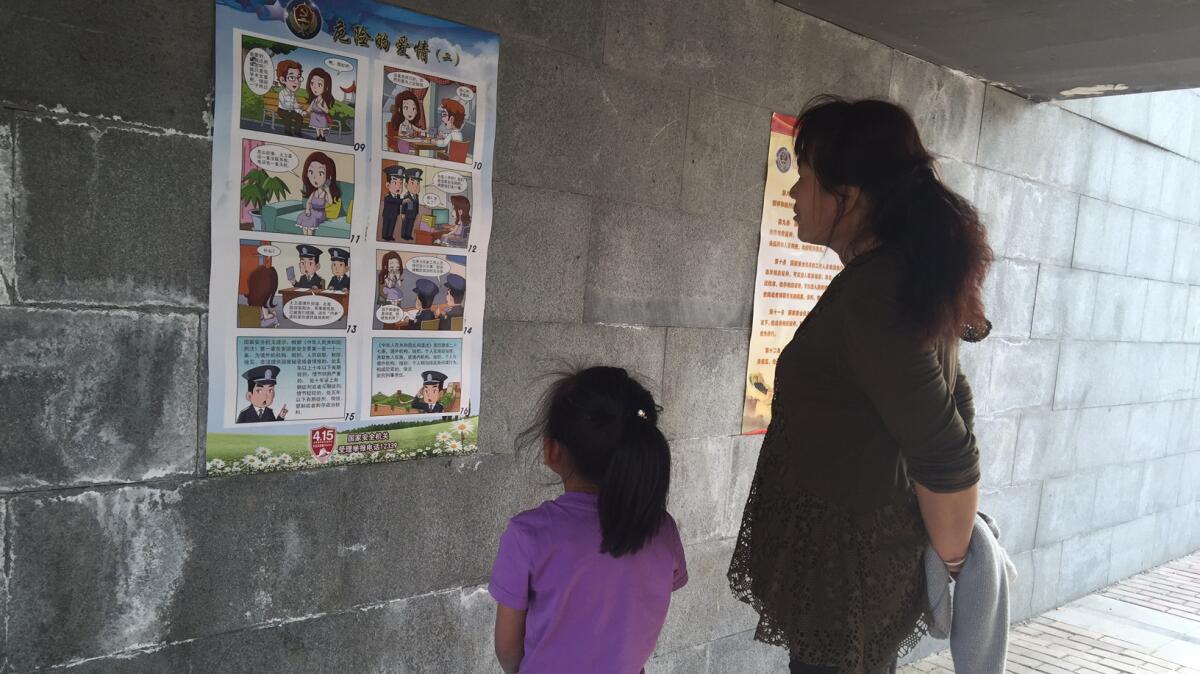‘We need to be clear-eyed and vigilant’: A look inside China’s national spy museum
- Share via
Reporting from Nanjing, China — The Yuhuatai Memorial Park of Revolutionary Martyrs is hallowed ground for the Chinese Communist Party. Here stand a soaring monument and super-life-size reliefs to honor the memory of party members, most then operating as secret agents, executed by the Nationalist government in the 1930s and ’40s.
Today, hordes of mostly elderly tourists pose with the Communists’ hammer-and-sickle flag.
Yet the most recent addition to the site has garnered less interest than the memorial, or the souvenir stalls nearby — but serves as a tangible testament to China’s perennial preoccupation: espionage.
Billed as the country’s only such institution, the Brutalist, barrel-shaped Jiangsu National Security Education Exhibition Hall — a.k.a. the Spy Museum — opened in 2009, closed for more than a year and reopened in mid-April after a face-lift. The reopening came on China’s inaugural national security education day.
The newly renovated exhibition hall has emerged as a showcase of curated propaganda about the myriad threats posed by foreign spies. Gone is a warning sign in four languages that once barred all foreign visitors.
The museum affords a window on the full array of perceived national security threats, internal and external, that China wants its people to fear.
“The regime appears to be accelerating counterintelligence efforts in response to fears of spies,” said Matthew Brazil, a former U.S. Army intelligence officer who has done doctoral research on Chinese Communist intelligence systems. “This is part of a historical continuum in [Chinese Communist Party] history.”
Spy museums are not unique to China. Washington has the International Spy Museum, and there are museums devoted to the Soviet KGB in both Moscow and Prague. While others tend to trade in Cold War nostalgia, China’s museum reflects more contemporary concerns.
Upon entering, visitors are reminded that Communist Party members got their start as covert agents long before they won the civil war in 1949 against the ruling Nationalists. Reproduced black-and-white photos show the hideouts of Communist coders in Shanghai. A well-thumbed code book is preserved for display.

But this is not a mere stroll down memory lane. The purpose is to mobilize the public to join the fight. Prominently posted at the entrance is the number of the national report-a-spy hotline: 12339.
On the second floor is a brightly lit showroom of security threats organized into various sections, including areas devoted to most of the neighboring countries: Japan, South Korea, Taiwan, Vietnam.
Although most of the contents are drawn from recent years, yellowed newspaper clippings about Americans John Downey and Richard Fecteau take up significant real estate. The CIA operatives were captured in 1952 during the Korean War after their plane crash-landed near the border in Jilin Province.
The CIA, not surprisingly, gets its own section, complete with multimedia elements. A video montage opens with the exterior of CIA headquarters at Langley, Va., and concludes with an evil-looking bald eagle, hammering home the message that the agency coordinates American spy activities against China.
National Security Agency whistleblower Edward Snowden also makes an appearance in an extended clip in which he explains the workings of PRISM, the electronic surveillance program.
The section on corporate espionage features the last two foreign nationals put on trial, both in 2010: Australian mining executive Stern Hu and American geologist Xue Feng. Xue, who was deported last year to his Texas home, is featured in a mug shot along with photos of oil reserve survey maps from Inner Mongolia as his smoking guns.
The richest store of objects on display can be found in the section on domestic threats: Tibetans, Uighurs and followers of Falun Gong, the spiritual practice outlawed since 1999 as a cult.
The sub-section on Tibet reflects China’s long battle to suppress the Tibetan independence movement and marginalize its exiled Buddhist spiritual leader, the Dalai Lama. It includes a miniature Snow Lion flag, autographed photos of the Dalai Lama (images that are banned in Tibet itself) and a handwritten letter in Tibetan purportedly detailing attack plots.
The Uighur display is dominated by illustrated diagrams on the East Turkestan Independence Movement and World Uighur Congress — groups that are banned in China. That is supplemented with publications in Arabic and Turkish that are described as pamphlets on violent jihad.
The Falun Gong exhibit focuses on the prodigious output of Li Hongzhi, the charismatic founder now living in exile in the U.S. A stack of cassette tapes of his recordings and a bundle of his canary-yellow-covered handbooks are presented as the bounty of evidence of his proselytizing.
According to the presentation, some of his followers made a daring attempt in 2014 to broadcast propaganda across the Taiwan Strait. The proof is by far the most ingenious object on display: a helium balloon fitted with cone-shaped loudspeakers. As many as 3,000 were to be flown over to China’s coast, the exhibit says.
During a two-hour stretch on a Saturday morning, hundreds of people visited the park, but only four bothered to enter the museum. At least one recent visitor was impressed.
“We need to be clear-eyed and vigilant about threats to our national security,” read a comment in the guest book.
For Brazil, the former intelligence officer, the exhibition signals a return to mass mobilization by the Chinese government. But then, “just because they’re doing it, it doesn’t mean it’s a roaring success,” he said.
Law is a special correspondent.
More to Read
Sign up for Essential California
The most important California stories and recommendations in your inbox every morning.
You may occasionally receive promotional content from the Los Angeles Times.










